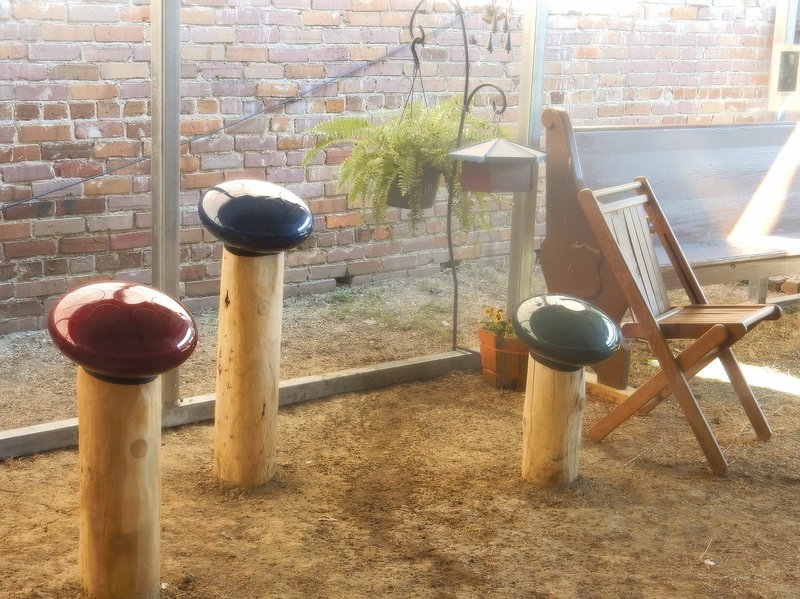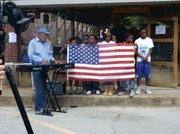"The [1919] Elaine Massacre was by far the deadliest racial confrontation in Arkansas history and possibly the bloodiest racial conflict in the history of the United States," reads the Encyclopedia of Arkansas. Yet few people know the story, said Pat Kienzle of Fayetteville.
The board of directors of the Lee Street Community Center in Elaine, of which Kienzle is a member, now help share the story. Turning Point Park, which sits in a once-empty lot under two donated carports, opened with a dedication ceremony Oct. 1.
Planners hope the park will attract visitors to Elaine with outdoor musical instruments -- constructed in part by members of Rolling Hills Baptist Church in Fayetteville, where Kienzle has been a member for more than 40 years. Once in the park, visitors can read displays dedicated to the incident.
JIM CROW
"Black sharecroppers in the cotton country around Elaine, Arkansas, decided that their landlords oppressed and cheated them. On the night of Sept. 30, 1919, they met in the Hoop Spur church to plan ways of getting help from a lawyer. Armed white men attacked them; in the fight that followed, one white man was killed," read U.S. Supreme Court Justice Oliver Wendell Holmes, introducing the cases of five black men accused of murder during the violence.
"Holmes gave their story as it appeared from the trial record and the sworn statements of other witnesses," according to the website of the Supreme Court Historical Society. The story continues on the web site:
News and rumors spread; armed posses hurried to Elaine. Blacks were hunted down and shot, even women working in the cotton fields.
Frank Moore faced an Arkansas electric chair; so did Ed Hicks, J. E. Knox, Ed Coleman and Paul Hall. All five were Negroes. When a federal district court said that it could not help them, they took their petition for a writ of habeas corpus to the Supreme Court, and raised the question: How does the Constitution protect the right to a fair trial in state courts?
The governor asked the Army to restore order, and named a committee of seven to investigate the riots. When a lynch mob surrounded the jail, soldiers stood guard while the committee promised that the law would execute the five murderers. The mob waited to see what would happen.
Two white men and several blacks swore later that the committee tortured blacks until they agreed to testify against the prisoners. Indicted by a white grand jury for first-degree murder, the defendants faced a white trial jury on Nov. 3; a threatening crowd filled the courthouse and the streets outside. In 45 minutes the trial was over; in two or three minutes the jury gave its verdict: "Guilty."
From the affidavits presented to the court, Holmes concluded, "if any prisoner by any chance had been acquitted by a jury he could not have escaped the mob."
All appeals in the state courts had failed. Normally, federal courts will not interfere with the courts of any state on matters of state law. But, warned Holmes, if "the whole proceeding is a mask" -- if "an irresistible wave of public passion" sweeps the prisoners through the courts "to the fatal end" -- then nothing can prevent the Supreme Court "from securing to the petitioners their constitutional rights."
The district judge should have examined the facts for himself, Holmes ruled, to see if the story in Moore's petition was true and if the state had not given its prisoners a fair trial. Moore vs. Dempsey went back for the district judge to hear.
Eventually, all five defendants went free; so did nearly a hundred other blacks arrested during the riots. Federal judges had a new precedent, citizens a new safeguard. Justice may wear a blindfold, ruled the Supreme Court, but not a mask.
"Holmes, along with all but two judges, believed that the 14th Amendment's purpose was to protect the basic rights of all citizens," wrote Kienzle, a former teacher, in a synopsis of her study of the event. "He wrote that all citizens had to be protected with due process under the law. States could not use different sets of rules for different races."
PICKLE LADY
When the state legislature required counselors for each elementary school in the state, Kienzle, a 28-year first-grade teacher, served as the first elementary school counselor in Farmington. A grant put her on the road in 1998 explaining the counseling program to parents and children throughout the state. Her program included an acronym for PICKLE, and a motto stating: "A pickle is a little bit sweet and a little bit sour. Counselors will talk to you when life is a little bit sweet, or a little bit sour, or at other times to."
Elaine appeared on the radar of the Fayetteville church in 2000, when the Cooperative Baptist Fellowship decided to reach out into the 20 poorest communities in the United States. Two in Arkansas -- Lee [county seat: Marianna] and Phillips [county seat: Helena-West Helena] -- both in the Mississippi River Delta, were on the list.
"Elaine is situated on a peninsula of land [in Phillips County] where the White and Mississippi rivers come together," explained the Rev. Steve Sheely, pastor of Rolling Hills Baptist Church in Fayetteville.
"After agriculture was mechanized, labor was not needed in the cotton and rice fields that surround the town," he continued. "Families are stuck there, but there are very few jobs. The population is under 600, but there are three federal housing projects located in the town. And it's still very segregated."
The town used to boast of a movie theater and five grocery stores, Kienzle said. But now Main Street is home the Post Office, the library, City Hall, and everything else is crumbling.
"And when the school closed [in 2006] due to consolidation [with the Marvell School District], kids had to ride the bus for more than an hour each day," Kienzle continued. "And at home and during the summer, they pretty much just 'hang out.' There was no venue for community events and no positive activities for the kids."
Kienzle said she simply took her activities to the parking lots of the projects.
"Used to, when a white lady would drive up, everyone would call their kids in," she said. "Then they started calling me 'The Pickle Lady.' They'd run yelling, 'The Pickle Lady is here.'"
Then Kienzle met George Andrew Gibson of Helena, pastor of Divine Deliverance church. He grew up in Elaine, and with his success in life, his dream was to build a community center for Elaine. Kienzle joined the efforts of Gibson and others, who eventually became the Lee Street Community Foundation.
In 2008, they opened a two-room portable school building moved to the site and renovated by members of various churches, including Rolling Hills. The building remains home to vacation Bible school programs, parenting classes and summer activities, with churches supplying resources and leaders. The recent purchase of a former medical clinic downtown will allow for a converted dormitory for volunteers working on foundation projects, Kienzle said.
"Part of our challenge is, every time we walk in those doors, we are teaching them something -- even if it's just to wait until the toys are uncovered," Kienzle said.
Wanting activities that both boys and girls would enjoy, the foundation and various churches provided birdhouses and supplies for painting them to the children. "We're still hoping for a market for them. But what do we do with these birdhouses but decorate the town?" Kienzle asked. Research soon told her there was no town designated as the "Bird House Capital," so she grabbed the designation for Elaine.
The foundation has more than 1,000 bird houses displayed in the town, including in a downtown store front that houses the project's headquarters. Four hundred more await display, Kienzle added. "So those are our three main goals," Kienzle said of the foundation's community center, birdhouse project and park. "And we started out just to do activities for the kids."
"They were this little town that had been forgotten. They had given up," Sheely said. "Now it's showing little signs of life, a little bit of color and a little bit of care.
"We want to empower the kids to take care of their community."
REMEMBRANCES
Kienzle said she had been working with people in Elaine for seven years before she knew about the 1919 incident in the town. In fact, her first history lesson on the town came during a film festival at the University of Arkansas.
"Older folks [in the town] don't want to talk about it," Kienzle said. "They say 'to leave the past in the past.'
"But we thought a nice garden or a park ought to recognize this major racial turmoil. Our park is 'Turning Point Park,' recognizing a turning point in the Civil Rights Movement."
In addition to the musical instruments, the park displays panels dedicated to key figures in the saga, Scipio Jones, T.K. Jones (no relation) and Henry Smiddy.
Scipio Africanus Jones was the son of a slave, who was not allowed to go to law school, but studied with white lawyers and passed the Arkansas bar exam, Kienzle explained. "The leading black attorney for his era in Arkansas," the online Encyclopedia of Arkansas reads, Jones was only allowed to practice law only when partnered with white lawyers, Kienzle wrote in a history. Jones worked closely with George Murphy and Edgar McHaney -- in fact, led the case when Murphy died -- to make the appeals and secure the release of the convicted men.
T.K. Jones and Smiddy were involved with the mob and had even participated in the violence against the blacks. "They put their lives in danger to give sworn affidavits with details telling what really happened," reads an interpretive panel in the park. "Those details matched the testimony of the prisoners. Those little-known men changed lives in the 1920s and in history today."
"There's also the doors of an old church and one-room school house," on display in the park, Sheely said. Picked up by the 1927 flood of the Mississippi River, they were set down by the water in a field near Elaine. "They stayed where they landed," he said.
The building served as a school for black children until 1945, Kienzle picked up the tale.
"I wanted to keep the doors," she said. "A lot of people's hands touched those door knobs. I bet people who were affected by the massacre turned those doorknobs. What if children who lost their parents went to that school?"
NAN Religion on 10/15/2016



